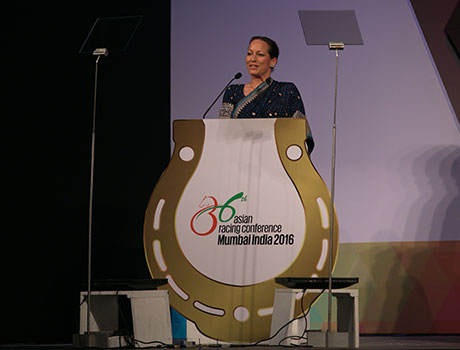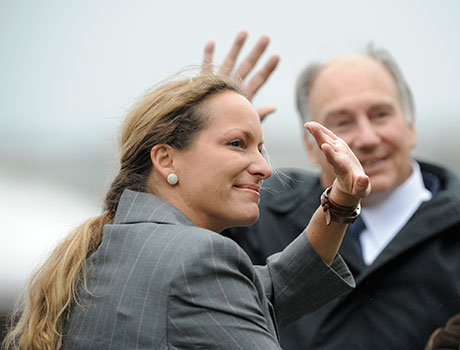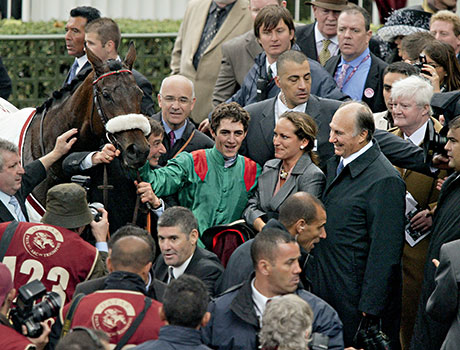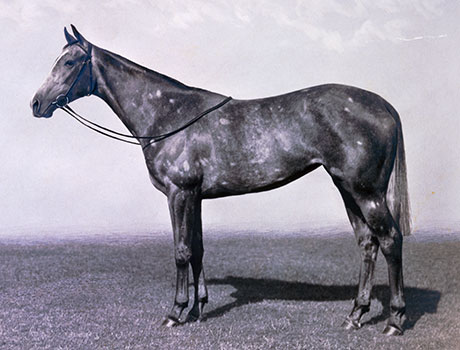



Mumbai, 25 January 2016
Honourable Governor
Honourable Delegates
Racing friends
In the late 19th century my great-great-great grandfather was racing horses all over undivided India. He had brought his stock from Persia, where the family had been breeding horses for many generations.
Included in those horses in the late 19th century, were Shere Ali, who won the Arab Derby in 1869, Khusroo who won the Winner’s Handicap in 1870, and Maharaj, who won loads of stuff including the Governor’s Cup and the Derby in 1872.
In the 20th century my grandfather and great-grandfather also raced their horses throughout India, to win races like the Indian Oaks with Ferial in 1945, four Viceroy’s Cups between 1928 and 1940, seven Eclipse Stakes of India between 1926 and 1956… and in 1922 my great-grandfather bought his foundation mares with Major Hall in Newmarket. Included in those lots was Mumtaz Mahal the “flying filly”, and her blood still runs in the veins of our families today, and in mares like Zafayra and To The Manor Born who are in the Indian Studbook.
My father, His Highness the Aga Khan, has maintained this family tradition for 55 years, winning an international total of 15 Derbies, 13 Guineas, 7 Prix de Diane, 4 Arcs – but not the Indian Oaks… yet!
How have these families survived and flourished through 250 years and six generations of the Aga Khan family?
Along with all the usual variables that we breeders look at such as conformation, distance aptitudes, character, physical fragilities, etc., we have an explicit policy of maintaining the genetic diversity of our broodmare band. We are constantly trying new matings and sire-lines, to try to preserve our families and revive those who have gone dormant.
Take for example the expanse of time between Petite Etoile’s last Group 1 win in the 1961 Coronation stakes, and the next Group 1 win by a filly from that family, Zainta’s 1998 St Alary: it took 37 years to revive that branch of Mumtaz Mahal’s line, but when it was revived, it gave us Zarkava, probably the best filly ever bred under my father’s ownership.
This is thanks to my father’s perseverance, but possibly also thanks to the variable that we consider the least when taking our breeding decisions: cost. I do not mean that we go to the most expensive stallions and are blind to the expense - quite the contrary. You will often see good Aga Khan mares visiting unfashionable and affordable stallions, and you may wonder… why?
For one thing it is because we run our bloodstock operation as a business, with solid principles and financial caution, a constant quest for excellence and respect for best practices – but, perhaps more importantly, it is because we consider the pedigree first, and the market last.
We are very fortunate to be able to take our breeding decisions based purely on the “fit” between the mare and the stallion, and not based on the eventual sales value of the yearling or the foal. As traditional breeders we have the luxury of protecting our families by making sure that we do our very best every single year to find the best horse for each mare, regardless of the commercial appeal. Of course, we have to sell some stock every year to keep the numbers manageable, but this is not driven by a financial imperative. In short, we do not follow fashion: we can decide whether we feel a horse will make a good mate for one of our families.
The cost of a nomination used to be dictated by the success of that stallion’s offspring on the racecourse, but more and more often it is now driven by vogue. An unproven first-season sire can command prices that are entirely unrelated to his ability to pass on, speed or strength or bone, or even the viability of his genes as a thoroughbred. On the other hand, stallions are judged within a very few years and retired to exotic locations for misdemeanour offenses in their first two crops. It is a shame because sometimes we find out too late that such and such a horse would have made a good sire or a good broodmare sire.
How can we ensure the future of the breed if every year hundreds of mares are mated to unproven first season sires that are completely unproven and statistically, likely to fail? What happens to the hundreds of foals that will never make good race-horses? How can we preserve the genetic diversity of the breed, and avoid fashions that focus solely on speed or precocity of one sire-line, at the expense of those other sire-lines who may eventually produce the great champions of the future? How can we maintain and improve the genetic capital of the thoroughbred and expand the gene pool, rather than reducing it for short-term, profit-driven purposes?
The answer may be a question of cycles. The “horse business” was much more patient in the past, allowing years to pass before mares and stallion were given either a pedestal, or a push into the dungeons of the forgotten. Today, breeders and owners expect rapid returns from their investments but frankly, the breeding business cannot be rushed. Nature dictates, and all the trendiness in the world won’t prove a stallion successful because of a sales catalogue. Judging success should be confined to the results achieved on the great racecourses of the world and not in the sales ring.
In centuries to come, the thoroughbred would be better off possibly, if breeders concentrated on the horse, rather than the sale of the horse, and the stallion as a viable procreator, rather than as a source of profit.
Racing and breeding have always been seen as a high-end activities, a frivolity associated with silly hats but I would like to underline the fact that 90% of the time and effort involved in creating a race horse are anchored in the rural economy and most of us spend far more time in our welly-boots than in our top hats.
The horse industry is an important part of the rural economy, employing millions of people around the world in areas of shrinking agricultural production. It supports farms and villages, it provides permanent, year-round employment to riders, lads, farriers, vets, farmers and businesses of all kinds.
As my father said, “You can look at the horse in human life — in agriculture, in war, or as a vehicle of exploration — for hundreds of years. When you think about it, the horse is one of the most extraordinary phenomena we have.” This industry preserves a species, and also an entire population that nurtures that species.
I may have given the impression that breeding plays a central role in my family’s activities, but in fact, for the Aga Khan family, it’s a “weekend job”, it’s a peripheral activity. As many people know, we spend 99% of our time working on development projects in Africa, and South and Central Asia, and in many sectors, from micro-finance to healthcare and education, from agro-industry to rural development, including here in India where our institutions have been present for more than a hundred years. This means that the business of breeding and racing horses has to fit into the limited amount of time that can be devoted to hobbies, and we are lucky to have a team of dedicated and highly-qualified colleagues who do a great job of handling “the business” on a daily basis.
Nevertheless, I think that this “weekend job” is an important one, because it represents 250 years of family tradition, and it maintains ties with our Persian and Indian history. Many of the families in our studbook have been with us since 1922, and they are old friends.
In 1939 my great -grandfather won the King Emperor’s Cup in Calcutta with Baqlava, a horse from the same family as Shahrastani, a family still present in our stud book today. In 1942 he won the Eclipse Stakes of India here at Mahalakshmi, with Golden Fawn, from the Mumtaz Mahal family. Today there are 125 mares from the same family in the Indian Studbook, and it has won more prize-money than any other in this country. Two of the top first-season sires in India, Arazan and Varenar, are Aga Khan-born and raced. Last Friday, Angel Dust won the Bangalore Derby – she is out of an Aga Khan mare. We are proud and honoured to be associated with racing and breeding in India and around the world after so many years and so many generations, and we intend to continue this time-honoured tradition.
Bahut shukriya